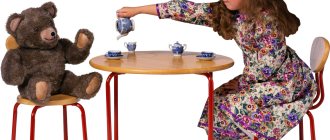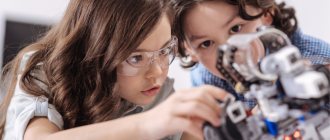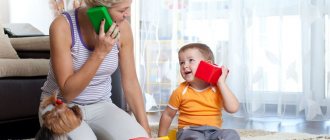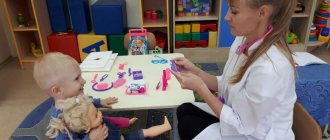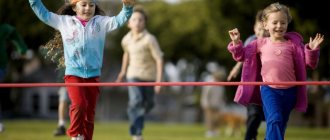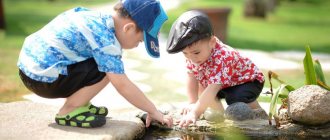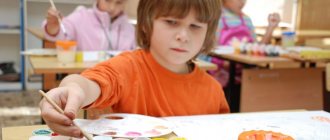Presentation “Development of gaming activities in the light of the Federal State Educational Standard” presentation on the topic
Slide 1
Teacher: E.V. Filkina
Slide 3
Federal State Educational Standard for Preschool Education - Federal State Standard for Preschool Education - a document that came into force on January 1, 2014.
Slide 4
The new standard of preschool education is designed to return play activities to preschool institutions. Many of its sections are devoted to the conditions for the formation of initiative and independent activity of children and, above all, free play.
Slide 5
The state’s social order for the education system is formulated in the main regulatory documents - the Law of the Russian Federation “On Education”, the Federal State Standard for Preschool Education - this is the education of an initiative, responsible person who is ready to make independent decisions in a situation of choice. Each type of activity of a preschool child has a unique impact on the development of different components of independence, for example, play contributes to the development of activity and initiative. Initiative and independence are most clearly manifested in games with rules. According to A. N. Leontyev, mastering a rule means mastering one’s behavior. Therefore, the teacher’s task is to motivate children’s play actions by directly participating and emotionally becoming involved in children’s games. In the role of the organizer of the game, the teacher introduces rules into the child’s life, and in the role of a detached observer, he analyzes and controls the children’s actions. Only the combination of these roles can ensure the development of will, volition, and independence of preschoolers as the main social and normative age characteristics of children at the stage of completion of preschool education.
Slide 6
The standard was developed taking into account the UN Convention on the Rights of the Child, the Constitution of the Russian Federation, and the legislation of the Russian Federation, which are based on the following basic principles:
Slide 7
The game is a cross-cutting mechanism for the development of a child (clause 2.7. Federal State Educational Standard for Education), through which the content of five educational areas is implemented: “Social and communicative development”: “Cognitive development”; “Speech development”; “Artistic and aesthetic development”; "Physical development". The specific content of play activities depends on the age and individual characteristics of children, is determined by the tasks and goals of the Program, this is reflected in the Standard of Preschool Education. In paragraph 2.7. The Federal State Educational Standard for Education defines the features of the development of a child’s play activity: - in infancy (2 months - 1 year) direct emotional communication with an adult, manipulation with objects...; - at an early age (1 year - 3 years) - object-based activities and games with composite and dynamic toys... communication with an adult and joint games with peers under the guidance of an adult...; - for preschool children (3 years - 8 years) - gaming activities, including role-playing games, games with rules and other types of games, communicative (communication and interaction with adults and peers).
Slide 8
For the development of a child, it is important to develop play activities, since this will allow the formation of social and normative age characteristics to be achieved (clause 4.6 of the Federal State Educational Standard for Education): - the child masters the basic cultural methods of activity, shows initiative and independence in various types of activities - play, communication, cognitive and research activities , design, etc.; is able to choose his occupation and participants in joint activities; - the child actively interacts with peers and adults, participates in joint games. Able to negotiate, take into account the interests and feelings of others, empathize with failures and rejoice in the successes of others, adequately expresses his feelings, including a sense of self-confidence, tries to resolve conflicts; - the child has a developed imagination, which is realized in various types of activities, and above all in play; the child knows different forms and types of play, distinguishes between conventional and real situations, knows how to obey different rules and social norms; - the child has a fairly good command of oral speech, can express his thoughts and desires, can use speech to express his thoughts, feelings and desires, construct a speech statement in a communication situation.
Slide 9
Three interconnected lines of child development fit harmoniously into the child’s natural environment - a game that for him is both entertainment and a way of understanding the world of people, objects, nature, as well as the sphere of application of his imagination.
Slide 10
One of the main principles of the Standard: – implementation of the Program in forms specific to children of a given age group, primarily in the form of play, cognitive and research activities, in the form of creative activity that ensures the artistic and aesthetic development of the child. (clause 1.2. (4))
Slide 11
The ideas for children's games can be both monotonous and varied. The more diverse the ideas, the more interesting the games, and this directly depends on impressions of the world around us. Consequently, in order for the ideas of the games to be diverse, and the games to be meaningfully interesting, a serious approach to planning and carrying out work to familiarize themselves with the outside world is required (educational area “Cognitive Development” (clause 2.6 of the Federal State Educational Standard for Education).
Slide 12
One of the basic principles of preschool education (clause 1.4 of the Federal State Educational Standard for Preschool Education) is the amplification (enrichment) of the conditions for the development of preschool children. Therefore, in the third section of the Standard - “Requirements for the conditions for the implementation of the basic educational program of preschool education”, among the conditions necessary to create a social situation for the development of children corresponding to the specifics of preschool age (clause 3.2.5), the following is emphasized: • creation of conditions for children’s free choice of activities , participants in joint activities; • support for children's initiative and independence in various types of activities (play, research, design, cognitive, etc.); • supporting children's spontaneous play, enriching it, providing play time and space.
Slide 13
This is the most important part of the work of teachers, the implementation of which determines the successful development of the child, which will allow the teacher to achieve the formation of target guidelines outlined in the Standard. The requirements of the Federal State Educational Standard for Educational Education for a developing subject-spatial environment (clause 3.3.) define (clauses 3.3.1 to 3.3.3) that: A developing subject-spatial environment ensures maximum realization of the educational potential of the space of the Organization, Group, and territory adjacent to the Organization or located at a short distance, adapted for the implementation of the Program (hereinafter referred to as the site), materials, equipment and supplies for the development of preschool children in accordance with the characteristics of each age stage: For children of the third year of life there is a free and large space where they can be in active movement - climbing, riding. In the fourth year of life, a child needs a developed center of plot-role-playing games with bright features of attributes. In middle and senior preschool age, there is a need to play with peers, to create your own world of play (director’s play: small toys, construction sets, models, etc.), in addition, in the subject-development environment, the formation of psychological formations in different years of life should be taken into account . A developing subject-spatial environment should provide the opportunity for communication and joint activities of children (including children of different ages) and adults, physical activity of children, as well as opportunities for privacy.
Slide 14
The subject-spatial development environment must meet the requirements of the DL Standard (clause 3.3.3). A developing subject-spatial environment must be content-rich, transformable, multifunctional, variable, accessible and safe. 1) The richness of the environment must correspond to the age capabilities of the children and the content of the Program. Toys are of great importance. Their thematic diversity is directly related to children’s existing impressions of the world around them and their gaming interests. Ideas about the world around us are gradually enriched, and in accordance with this, the set of imaginative toys gradually expands. Therefore, play corners should not be stocked with the same toys from the beginning of the school year to the end. We should not forget about such a simple technique in equipping the play environment, when some toys are removed for a while and then returned again. A newly appeared familiar toy makes you want to play with it. In groups of educational organizations, centers for role-playing games are created: “Home”, “Shop”, “Hospital”, “Hairdresser”, “Workshop” and other theatrical centers; various types of theaters; screens; attributes, a acting center, a music center, upholstered furniture, toys: dolls, cars, etc. Small toys for stage games, printed board games, lotto, dominoes. Different types of construction sets, cubes, building material. Didactic material for educational activities. Layouts, maps, models, dummies, group diagrams, substitute items.
Slide 15
2) Transformability of space implies the possibility of changes in the subject-spatial environment depending on the educational situation, including the changing interests and capabilities of children; the possibility of varied use of various components of the subject environment, for example, children's furniture, mats, soft modules, screens, etc. 3) Multifunctionality of materials implies: the possibility of varied use of various components of the subject environment, for example, children's furniture, mats, soft modules, screens, etc. .d.; the presence in the Organization or Group of multifunctional (not having a strictly fixed method of use) items, including natural materials, suitable for use in various types of children's activities (including as substitute items in children's play). So, along with figurative toys, generalized material should be presented, first of all, substitute objects. Their combination allows children to realize their wildest ideas in the game.
Slide 16
4) Environmental variability presupposes: the presence in the Organization or Group of various spaces (for play, construction, privacy, etc.), as well as a variety of materials, games, toys and equipment, ensuring the free choice of children; periodic change of play material, the emergence of new objects that stimulate the play, motor, cognitive and research activity of children. 5) Accessibility of the environment implies: accessibility for pupils, including children with disabilities and children with disabilities, of all premises where educational activities are carried out. Using large game materials, children replace not just one object in the game, but a whole complex of objects, for example, they built a ship, and cubes or plates - boats or ice floes. Removable panels - paintings - add variety to the design and help in realizing the plan. . 6) The safety of the object-spatial environment presupposes that all its elements comply with the requirements for ensuring the reliability and safety of their use: cases of falling from a height, falling out of the side surfaces of products, blows and bruises as a result of the instability of the latter, injury from sharp corners, etc. are excluded.
Slide 17
Federal State Educational Standards requirements for a subject-developing environment: A subject-development environment ensures maximum realization of educational potential. Accessibility of the environment, which implies: Accessibility for students of all premises of the organization where the educational process is carried out. Free access for pupils to games, toys, materials, and aids that provide all basic activities. The organization of the developmental environment in preschool institutions, taking into account the Federal State Educational Standard, is structured in such a way as to make it possible to most effectively develop the individuality of each child, taking into account his inclinations, interests, and level of activity.
Slide 18
Game is one of the key areas of the standard. The game form of conducting classes has no relation to real free play. First of all, play is an initiative activity of children, and classes are activities organized by adults. The world of play belongs to the child; like any creativity, it contains an element of surprise. Today, a teacher is required to be able to navigate the world of modern games and toys, maintaining a balance between the child’s desire and benefit for him, paying more attention to modern non-traditional didactic and educational computer games, promoting adequate socialization of the child.
Slide 19
Therefore, kindergarten teachers in any type of children’s activity need to provide children with as many opportunities as possible to demonstrate their independence. Do not force the game on children, but do not leave it without guidance. Even among older preschoolers, independence in play is relative. Therefore, children need support in developing ideas, clarifying game actions, and assigning roles. And here there is nothing better than the teacher himself becoming a playing partner.
Slide 20
The main principle of the new Federal State Educational Standard for preschool education: the child’s activities should be as diverse as possible, for which selection diagnostics, which seeks to identify a child who has a certain set of educational skills, is replaced by developmental diagnostics, which aims to diversify the child’s knowledge, skills and abilities as much as possible. “Requirements for the results of mastering the basic educational program of preschool education” - “Target guidelines at the stage of completion of preschool education: •... shows initiative and independence in various types of activities - play, communication, cognitive and research activities, design, etc....; •... actively interacts with peers and adults, participates in joint games; … • the child has a developed imagination, which is realized in various types of activities, and above all in play; the child masters different forms and types of play, distinguishes between conventional and real situations, and knows how to obey different rules and social norms. ... (4.6.)
Slide 21
Game in the educational program of preschool education Direct educational activities - organization of didactic games in accordance with the content of educational work in educational areas Educational activities in the daily routine - organization of leisure, active, theatrical games, games with rules, organization of joint story games with the teacher. Free activity - pedagogical support for amateur children's games (role-playing, directorial, experimental games), as well as games with rules, outdoor, leisure, folk organized on the initiative of the children themselves
Slide 22
In the context of the implementation of the Federal State Educational Standard, children are taught through play, since play constitutes the main content of the life of a preschool child and is his activity. It activates the child’s mind and will, deeply affects his feelings, increases the vital activity of the body, and promotes physical development. Play is necessary for a child to grow up healthy, cheerful and strong.
